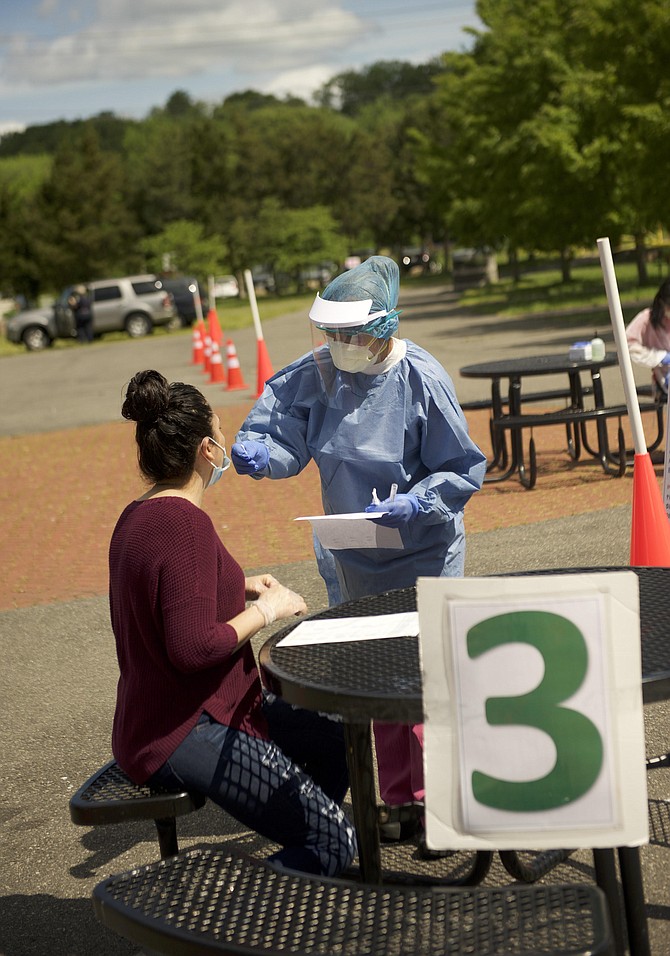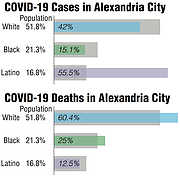Neighborhood Health, a local non-profit community health center serving primarily low-income and uninsured people in Fairfax County, Arlington and Alexandria held a COVID-19 testing day in the Arlandria neighborhood of Alexandria, where 236 residents received free COVID-19 tests on Saturday, May 16.
In Alexandria, the Latinx population, which comprises 16.8 percent of the City, accounts for 55.5 percent of Alexandria’s positive cases of COVID-19.
Arlington’s Latinx community makes up 15.8 percent of the county’s population, but accounts for 55.5 percent of the positive COVID cases. And Arlington’s black population which makes up about 1 in 10 people (9.6 percent) in the county accounts for almost 1 in 4 deaths (24.1 percent).
The population of Fairfax County is 16.8 percent Hispanic but Latinx individuals account for 65.3 percent of positive COVID-19 cases in Fairfax County.
By Sunday, June 14, months into the pandemic, African Americans accounted for 1,154 deaths, more than 41 percent of the total, in Maryland even though they account for 30.9 percent of the overall population.
Montgomery County’s black population had the highest rate per 100,000 individuals (79). And the African-American population in Montgomery County was the only demographic that had a greater percentage of deaths than its demographic predicts.
THE NORTHERN VIRGINIA Regional Commission concluded that Latinos accounted for a disproportionate number of coronavirus cases in this area.
“The Hispanic or Latino share of cases in Northern Virginia is three-and-a-half times their overall share. All health districts in NOVA have significantly higher shares [for the Latino population]. This indicates significant ethnic disparities in COVID 19 cases.”
Coronavirus cases by zip code in Northern Virginia also revealed disparities by race, ethnicity and economic status. In the City of Alexandria, zip code 22305 stood out for 579 cases.
“Although viruses do not discriminate, the COVID-19 virus disproportionately impacts vulnerable populations just as other diseases and health conditions do,” according to the Alexandria City Government, explaining some disparities.
The zip codes with higher concentrations of poverty, lower education levels, and crowded housing conditions tend to have the highest rates of COVID. These people are more likely to work in jobs where they are underpaid, don’t get paid sick leave, depend on public transit and don’t have telework opportunities, bringing more risk of exposure to coronavirus.
“Inequitable conditions have created disproportionate rates of chronic health issues resulting in large differences in life expectancy across Alexandria. Now, these chronic health issues also make people more susceptible to severe disease from COVID-19 infection,” the city report said.
“AFFLUENCE in Northern Virginia masks gaps in health and economic opportunity that have been exacerbated even further by the current coronavirus pandemic,” according to the Northern Virginia Health Foundation.
“Although everyone is potentially susceptible to the virus, research shows that people of color and low-income families are especially vulnerable and have higher death rates from COVID-19,” said Steven H. Woolf, of Virginia Commonwealth University and the Northern Virginia Health Foundation. “They have greater exposure to the virus, are more susceptible to complications, have greater barriers to health care, are more vulnerable economically, and suffer from deteriorating health caused by deepening economic adversity.”
Northern Virginia is a “seemingly affluent area” with good health statistics in general, but life expectancy varies by 17 years within the region, he said. “Economically marginalized communities will face devastating wage losses, unemployment and food scarcity. Low income families will undoubtedly struggle the most to rebound.”
THE PANDEMIC has magnified discrepancies that health officials already knew were there.
According to the Arlington County Government, “Arlington rightfully celebrates being highly ranked in many areas, like employment, education and health. However, looking beyond aggregate data and drilling into results in different geographic, ethnic, racial and other often-marginalized groups reveals that health disparities exist among Arlingtonians in these groups. Not everyone is thriving.”
According to the Fairfax County health department, “The data does underscore some of the existing disparities in Fairfax which make certain populations more susceptible to exposure and to greater risks from COVID-19 infection, just as they are for other diseases and health conditions.”
“Simultaneously, COVID-19 continues to showcase and exacerbate the disparities that exist in our most vulnerable communities,” said Fairfax County Chairman Jeff McKay.
“Now more than ever, we know it is the role of our local government to achieve true structural change in our communities. We in Fairfax County must honestly ask ourselves, ‘What actions are we taking?; What voices are we lifting up?;’ and for me as your Chairman, ‘Are our policies affecting systemic change in our community?’”
Some Changes, But It’s All About the Virus
Since the May 7, 2020 Alexandria health department report on zip code data, there have been significant changes. The May analysis included rates that varied from 2.3 to 19.7 cases per 1,000 residents in the zip codes that can be calculated. New data from June 9 shows rates ranging from 3.9 to 35.5 cases per 1,000 residents in these zip codes.
All Alexandria zip codes had decreases in their positivity rate. The zip code with the highest positivity rate in the May analysis, 22305 (55.4%), had a 46% reduction in the positivity rate, to 30.1% on June 9, but still has the highest positivity rate..
The virus has widespread community transmission throughout all of Alexandria, Northern Virginia, Washington, D.C. and Maryland, the City reports. An individual’s risk of becoming infected continues to be based on many factors, including individual exposures and health status, environmental conditions, policies and practices of businesses, and individual behaviors.
Disproportionate Impact
From the Alexandria Health Department and City:
“Although viruses do not discriminate, the COVID-19 virus disproportionately impacts vulnerable populations just as other diseases and health conditions do. The zip codes with the highest rates COVID-19 cases in Alexandria are also the zip codes with higher concentrations of poverty, lower education levels, and crowded housing conditions. The populations living in some zip codes have experienced discriminatory policies and systems, resulting in inequitable access to economic opportunities, affordable housing, and healthcare.
“Inequitable conditions have created disproportionate rates of chronic health issues resulting in large differences in life expectancy across Alexandria. Now, these chronic health issues also make people more susceptible to severe disease from COVID-19 infection. Additionally, these community members are more likely to work in jobs where they are underpaid; do not receive paid sick leave; and are not afforded telework opportunities, creating additional risk of exposure to the COVID-19 virus.”
Addressing the Inequality
From the Alexandria Health Department and City:
“The Alexandria health department has been working with vulnerable populations, community leaders and activists in communities of color and disadvantage for decades, including in the battles against HIV/AIDS, other communicable diseases and teen pregnancy. The Alexandria health department provides those communities with targeted prevention services such as immunization and sexual & reproductive health clinics and the Special Nutrition Program for Women, Infants and Children (WIC).
The department’s population health efforts engage residents and partners to identify barriers to ideal health, to help build solutions that make sense for everyone. AHD’s Community Health Assessment underscores the existing disparities in Alexandria. The project’s steering committee – a group of committed, diverse community members and leaders – used equity as their guide throughout the process. Community members reviewed the results of this work and chose three focal points – poverty, housing and mental health – for a five-year Community Health Improvement Plan, developed in tandem with the Partnership for a Healthier Alexandria.
Since originally becoming aware of COVID-19 in late 2019, AHD has been working with community partners that serve populations at high risk for severe illness if they contract COVID-19. Additionally, AHD prioritizes efforts to protect Alexandrians most at risk, particularly those over the age of 65 and those living in congregate living facilities (e.g. long-term care facilities, group homes, and detention centers).

